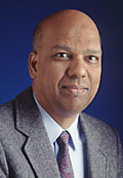 |
Virginia Tech, USAWebsite: http://www.ece.vt.edu/faculty/ramu.htmlEmail: |
R. Krishnan is a professor of electrical and computer engineering at Virginia Tech, Blacksburg, VA and directs the Center for Rapid Transit Systems in linear and rotating motor drives. He is the author of: (i) Electric Motor Drives (Prentice Hall), Feb 2001, its Chinese translation (Pearson Education Taiwan) in 2002, Indian Edition (Prentice Hall of India) in 2002 and International Edition (Prentice Hall International Edition) in 2001, (ii) Switched Reluctance Motor Drives (CRC Press), June 2001, (iii) Permanent Magnet Synchronous and Brushless DC Motor Drives (CRC Press), Sept 2009 and (iv) coeditor and coauthor of Control in Power Electronics (Academic Press), Aug 2002.
Krishnan has been granted seven US patents and many are pending in US, Europe and other countries. His inventions have been prominently featured in public media including radio, TV, and newspapers such as The Wall Street Journal. He has consulted extensively for 18 companies in USA. He has developed and delivered short courses for academia and industry on vector controlled induction, permanent magnet synchronous and brushless dc, switched reluctance and linear electric motor drive systems.
Krishnan is a recipient of best paper prize awards from IEEE Industry Applications Society’s Industrial Drives committee (5 awards) and Electric Machines committee (1 award). In addition, he received the first prize from IEEE Transactions on Industry Applications for his paper and the 2007 Best Paper Award from IEEE Industrial Electronics Magazine. His co-edited book Control in Power Electronics won the best book award from Ministry of Education and Sport, Poland, in 2003. He was awarded IEEE Industrial Electronics Society’s Dr. Eugene-Mittelmann Achievement Award for Outstanding Technical Contributions to the field of Industrial Electronics in 2003.
Krishnan is a Fellow of the IEEE and a Distinguished Lecturer of IEEE Industrial Electronics Society. He is an elected Senior AdCom Member of IEEE Industrial Electronics Society and served as its Vice President (Publications) from 2002 to 2005. He served as the General Chair of the 2003 IEEE Industrial Electronics Conference, Roanoke, VA, USA and as one of three General Co-Chairs of the IEEE IES’ ICIT 2006 in Mumbai, India. He has delivered many keynote speeches in IEEE conferences.
Krishnan and some of his graduate scholars’ inventions constituted founding technologies for three motor drives companies. He is the founder of: (i) Panaphase Technologies, LLC in 2002 that went through successful merger and acquisition (M&A) in 2007, and (ii) Ramu Inc., in 2008 specializing in high volume variable speed motor drives for home appliances, air conditioners, hand tools, wind power and automotive applications. He is also a co-founder of TransNetics, LLC specializing in intellectual property for linear motor drives.
Whither Motor Drives: A Case Study in Switched Reluctance Motor Drives
Variable speed motor drives and power electronics are at crossroads as their engineering and technology have matured, and products have found wide acceptance in world markets. A debate is going on about the future of both in academic and to a smaller extent in industrial circles with a broad consensus and agreement that there is no more fundamental work possible or breakthrough required in these disciplines. During this time American industries have almost decimated R&D in these disciplines indirectly reinforcing the notion that current technologies are sufficient to address the existing or emerging market needs. This is happening at a time when the energy crisis is at full blast and environmental concern is on upswing. It is illusory to think that these challenges can be faced by incremental work in product development as is the general trend and not by fundamental work. By reviewing the past it is demonstrated that the root cause of present situation and how the challenges of emerging market and societal demands can be met through a case study.
This paper presents the rise of power electronics and motor drives from late 1950s to present. The developments in semiconductor devices, power electronic converters and motor drives progressed from fundamental concepts and breakthroughs to tackling secondary problems and that path is briefly traced. In turn, this has contributed to the notion that the engineering in this field has matured. Many of these fundamental developments have come about due to market pressure and demands (a fact usually overlooked in academia) and that correlation is derived. The same market and environmental concerns can and do open up opportunities for fundamental work. A case study of recent work in switched reluctance motor drives is presented highlighting emerging newer directions in motor drives research and development driven primarily by the emerging markets and applications. It is demonstrated that there is no paucity of fundamental problems (but may be a lack of attention to market needs) that can provide the keys to happy kingdom of research and development for a newer generation of engineers, scientists and professors.